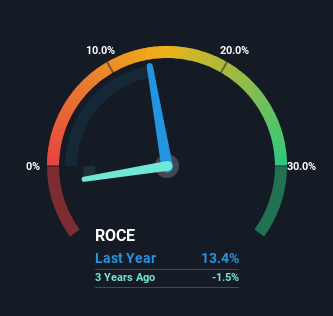If you're not sure where to start when looking for the next multi-bagger, there are a few key trends you should keep an eye out for. Ideally, a business will show two trends; firstly a growing return on capital employed (ROCE) and secondly, an increasing amount of capital employed. Basically this means that a company has profitable initiatives that it can continue to reinvest in, which is a trait of a compounding machine. So on that note, CMR. de (BMV:CMRB) looks quite promising in regards to its trends of return on capital.
Return On Capital Employed (ROCE): What Is It?
If you haven't worked with ROCE before, it measures the 'return' (pre-tax profit) a company generates from capital employed in its business. The formula for this calculation on CMR. de is:
Return on Capital Employed = Earnings Before Interest and Tax (EBIT) ÷ (Total Assets - Current Liabilities)
0.13 = Mex$249m ÷ (Mex$2.9b - Mex$1.1b) (Based on the trailing twelve months to September 2024).
Therefore, CMR. de has an ROCE of 13%. In absolute terms, that's a satisfactory return, but compared to the Hospitality industry average of 5.1% it's much better.
Check out our latest analysis for CMR. de

While the past is not representative of the future, it can be helpful to know how a company has performed historically, which is why we have this chart above. If you're interested in investigating CMR. de's past further, check out this free graph covering CMR. de's past earnings, revenue and cash flow.
What Does the ROCE Trend For CMR. de Tell Us?
CMR. de has not disappointed in regards to ROCE growth. We found that the returns on capital employed over the last five years have risen by 1,531%. That's a very favorable trend because this means that the company is earning more per dollar of capital that's being employed. In regards to capital employed, CMR. de appears to been achieving more with less, since the business is using 22% less capital to run its operation. A business that's shrinking its asset base like this isn't usually typical of a soon to be multi-bagger company.
In Conclusion...
From what we've seen above, CMR. de has managed to increase it's returns on capital all the while reducing it's capital base. Given the stock has declined 48% in the last five years, this could be a good investment if the valuation and other metrics are also appealing. So researching this company further and determining whether or not these trends will continue seems justified.
Since virtually every company faces some risks, it's worth knowing what they are, and we've spotted 3 warning signs for CMR. de (of which 2 make us uncomfortable!) that you should know about.
While CMR. de isn't earning the highest return, check out this free list of companies that are earning high returns on equity with solid balance sheets.
New: AI Stock Screener & Alerts
Our new AI Stock Screener scans the market every day to uncover opportunities.
• Dividend Powerhouses (3%+ Yield)
• Undervalued Small Caps with Insider Buying
• High growth Tech and AI Companies
Or build your own from over 50 metrics.
Have feedback on this article? Concerned about the content? Get in touch with us directly. Alternatively, email editorial-team (at) simplywallst.com.
This article by Simply Wall St is general in nature. We provide commentary based on historical data and analyst forecasts only using an unbiased methodology and our articles are not intended to be financial advice. It does not constitute a recommendation to buy or sell any stock, and does not take account of your objectives, or your financial situation. We aim to bring you long-term focused analysis driven by fundamental data. Note that our analysis may not factor in the latest price-sensitive company announcements or qualitative material. Simply Wall St has no position in any stocks mentioned.
About BMV:CMR B
Slight risk and slightly overvalued.
Market Insights
Community Narratives



